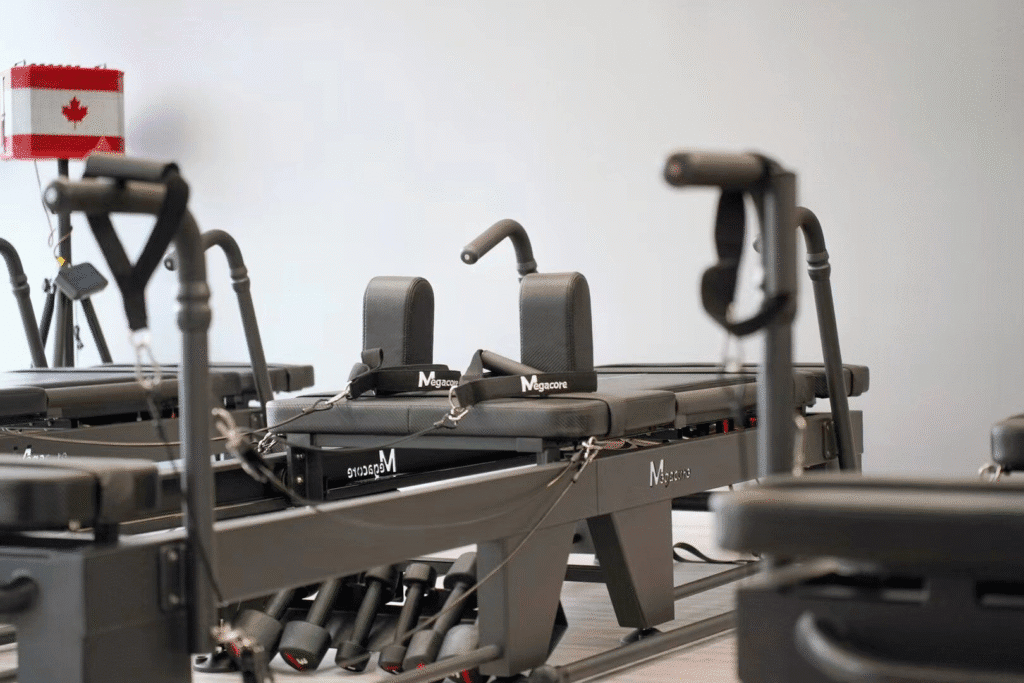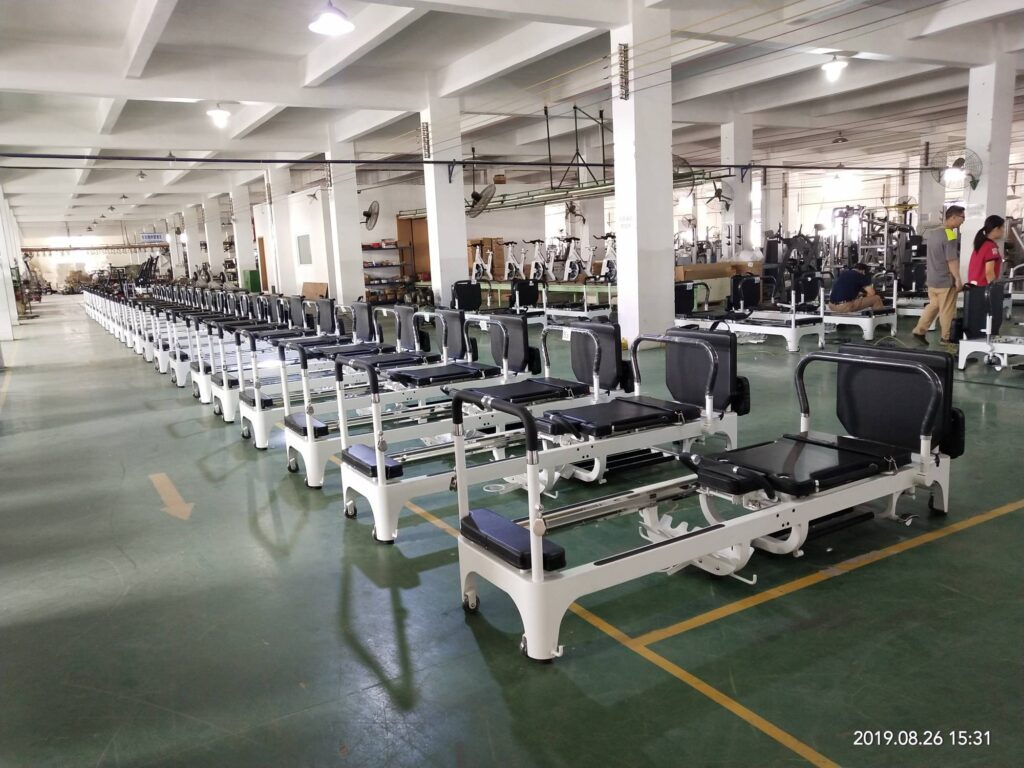A key reason the Pilates reformer has remained a mainstay in studios around the world is its remarkable adaptability. Designed to accommodate a wide range of body shapes, fitness levels, and experience, the reformer’s unique construction offers a level of personalization few other fitness machines can match.
At its core, the reformer features a gliding carriage set within a sturdy frame, which moves smoothly back and forth on wheels. This carriage is connected to springs of various resistance levels, allowing users to customize their workouts simply by changing the spring settings. Whether you’re just beginning your Pilates journey or are a seasoned practitioner, you can adjust the resistance to precisely challenge your body without compromising safety.
The reformer also includes key components like the adjustable foot bar and straps with handles. The foot bar can be repositioned to suit different movements and participant heights, while the straps can be used for both arm and leg exercises. This flexibility means exercises can easily be modified for someone recovering from injury, as well as for those seeking an advanced, full-body workout.
Because of its many adjustable features—springs, foot bar, headrest, and straps—the reformer is accessible for people of all sizes, ages, and fitness backgrounds. Whether someone is seeking gentle rehabilitation or looking to enhance athletic performance, the reformer meets them at their current level and continues to adapt as their strength and skills improve.

What Muscles and Movements Does the Pilates Reformer Target?
One of the key strengths of the Pilates reformer is its ability to deliver a dynamic, full-body workout with endless movement possibilities. Through carefully controlled resistance and a sliding carriage, the reformer challenges both large and small muscle groups that are essential for everyday movement and posture.
- Core Engagement: Expect deep work in the abdominals, lower back, hips, and glutes—collectively known as the “powerhouse” in Pilates speak. This translates to improved stability and support for the entire body.
- Upper Body Toning: Movements on the reformer frequently target the shoulders, arms, and chest, promoting toned, balanced muscles and better posture.
- Lower Body Sculpting: Squats, lunges, leg presses, and footwork sequences on the reformer engage the quadriceps, hamstrings, calves, and glutes, all while reducing impact on the joints.
- Flexibility and Range of Motion: The guided resistance and adjustable springs help lengthen muscles and encourage greater mobility, making it accessible for various fitness levels and body types.
- Balance and Coordination: Many reformer exercises also require precise control and stabilization, refining your sense of balance and body awareness with every session.
In short, whether you’re working on strength, flexibility, or overall coordination, the Pilates reformer is designed to adapt to your needs and challenge your body in new ways every time. However, the design and features of the reformers have changed significantly over time, reflecting the evolution of the Pilates movement and the fitness industry as a whole.
Timeless Design, Timeless Results
The enduring popularity of the Appareil d'exercice Pilates domestique is no accident—its continued use over generations speaks volumes about the method’s effectiveness. Unlike fleeting fitness fads, the reformer’s tried-and-true design has stood the test of time, continually delivering results for people of all ages and fitness levels. This lasting relevance not only highlights the thoughtfulness behind Joseph Pilates’ original vision but also showcases how adaptable Pilates reformers remain as modern fitness evolves. In this article, we’ll explore the history of heavy-duty Pilates reformers and how they have evolved to meet the needs and preferences of Pilates practitioners and fitness enthusiasts.
How Reformer Pilates Compares to Mat Pilates
One common question that arises for newcomers and seasoned practitioners alike is how Reformer Pilates stands apart from traditional mat Pilates. While both approaches share the foundational principles developed by Joseph Pilates—focusing on controlled movement, proper alignment, and mindful breathing—their methods and benefits diverge in a few key ways.
Mat Pilates utilizes your body weight as resistance and is typically performed on the floor with minimal equipment. It offers an excellent way to build deep core strength, stability, and awareness, and forms the basis for many Pilates exercises. However, some people may find mat work challenging if they have limited flexibility, mobility restrictions, or are recovering from injury.
The Pilates reformer, in contrast, introduces a spring-based system, footbar, straps, and a moving carriage. This equipment provides adjustable resistance and support, allowing for a greater variety of exercises that target the entire body—not just the core. The reformer can make some movements more accessible for beginners or those with physical limitations, while also offering a challenging level of intensity for athletic training. Its versatility promotes length, muscular strength, flexibility, and improved balance, making it a popular choice among dancers, athletes, and anyone seeking a well-rounded workout.
In essence, mat and reformer Pilates both offer significant benefits but cater to different needs and experience levels. Many practitioners choose to incorporate both for a more comprehensive Pilates practice.
Early Reformers
The earliest Pilates reformers were developed by Joseph Pilates himself in the 1920s and 1930s, when he first introduced his revolutionary method of exercise and rehabilitation in his New York City studio.
But the concept behind these machines actually began earlier, during World War I, when Joseph Pilates was interned on the Isle of Man. While working as a nurse in the internment hospital, Pilates used hospital beds, bed frames, and makeshift springs and straps to help bedridden patients stretch and strengthen their atrophied limbs. Drawing on his knowledge of yoga, Zen meditation, and breathing exercises, Pilates developed techniques that combined resistance, movement, and mindful breathing—laying the foundation for what would become the Pilates method.
After the war, Pilates continued refining his ideas, moving to New York City in 1923. There, he opened his first studio and introduced the world to the Pilates reformer—a machine inspired by those early hospital bed contraptions, featuring sliding carriages, springs, and straps to provide adjustable resistance for a wide variety of exercises. This innovative approach quickly caught the attention of dancers, athletes, and anyone interested in building strength, flexibility, and control.

The Birth of the Reformer During World War I
The origins of the Pilates reformer trace back to the resource-constrained environments of World War I. While interned on the Isle of Man, Joseph Pilates faced the unique challenge of rehabilitating wounded soldiers with little more than hospital beds and spare equipment. Ever inventive, he began attaching springs and straps to bed frames, ingeniously transforming them into makeshift exercise apparatus.
This simple yet effective setup allowed bedridden patients to benefit from controlled resistance and supported movements, aiding in recovery and muscle reconditioning. Pilates’ creative solutions during this period laid the groundwork for the reformer’s sliding carriage and resistance-based design that we know today. Through these early innovations, functional movement and mindful breathing became central to his approach, setting the stage for the Pilates method’s emergence as a robust system for both rehabilitation and fitness. Pilates used spare bed frames, springs, and ropes to create the basic structure of the reformers, which were designed to provide resistance and support for a variety of exercises. The reformers were relatively simple and compact, but they offered a challenging and effective workout that drew attention from dancers, athletes, and other health-conscious people. Despite their humble beginnings—constructed from spare bed frames and springs—these early reformers were remarkably adaptable. Whether used for physical therapy, athletic conditioning, postpartum recovery, or by those completely new to exercise, the reformer quickly proved its versatility. This wide appeal helped establish Pilates as a method that could meet practitioners exactly where they were, providing support, resistance, and a customizable experience that laid the foundation for the equipment’s enduring popularity.
Classic Reformers
In the 1960s and 1970s, Pilates reformers became more standardized and streamlined, thanks to the efforts of Pilates’ students and disciples who wanted to preserve and promote his legacy. The classic reformers featured a wooden frame, a padded carriage with straps, and a system of springs and pulleys that allowed for versatile resistance and movement. The springs were color-coded to represent different levels of tension, and the carriage could be adjusted for height and angles. The classic reformers were more comfortable and durable than their predecessors, and they became more widely used in Pilates studios and rehabilitation clinics.

Key Features of Classic Reformers
Classic reformers retained the essential elements that define the machine even today. They typically consisted of:
- A bed-like wooden frame supporting a flat, padded carriage that glided smoothly along rails.
- The carriage, attached to one end of the frame by a set of springs, offered multiple levels of resistance, creating time under tension as it moved back and forth.
- Adjustable shoulder blocks and a footbar at the spring end of the machine, which could be used by both hands and feet to facilitate a wide range of exercises.
- Long straps with handles anchored to the top end of the frame, providing yet another dimension of movement and resistance for both arms and legs.
This combination of body weight and spring resistance enabled practitioners to tailor each workout to their size, strength, and ability. As users became more skilled, the reformer could be adjusted to increase the challenge, ensuring continual progress. The adaptability and versatility of these classic machines made them suitable for a diverse array of users—from professional dancers to those recovering from injury.
Contemporary Reformers
In the 1990s and 2000s, Pilates reformers underwent a transformation to meet the demands and preferences of a changing fitness industry. The contemporary reformers feature a variety of materials, such as stainless steel, aluminum, and composite materials, that offer durability, stability, and style. They also have more adjustable features, such as a wider range of spring tensions, multiple footbar positions, and optional tower or jump board attachments. The contemporary reformers also come in different sizes and shapes, such as the box-style, the half-tower, and the combo reformer, that suit different spaces and workout needs.
Current Reformers
Today, heavy-duty Pilates reformers come in a wide range of styles, sizes, and prices, and they incorporate the latest technology and design innovations to provide the best possible user experience. Some examples of current reformers include:
– The AeroPilates Pro XP 557: This reformer features a cardio rebounder, adjustable resistance, and upgraded pulleys and straps for smooth and versatile movement.
– The Balanced Body Pilates Studio Reformer: This reformer offers a sturdy and versatile frame, adjustable straps and ropes, and a choice of custom colors and upholstery options.
– The Elina Pilates Elite Reformer: This reformer combines traditional craftsmanship with modern design, and offers a durable and responsive machine that supports advanced Pilates exercises.
– The Peak Pilates MVe Fitness Chair: This reformer features a compact and versatile design that combines Pilates and cardio exercises, and is ideal for home or small studios.
In conclusion, the evolution of heavy-duty Pilates reformers reflects the growth and transformation of the Pilates method and the fitness industry. While the basic principles of Pilates remain the same, the design and features of the reformers have evolved to offer more comfort, customization, and versatility to the users. By choosing the right reformer that fits your goals, needs, and budget, you can enjoy the benefits of Pilates for many years to come.

